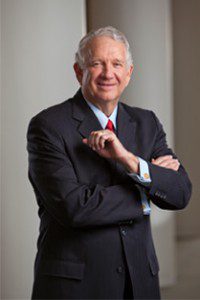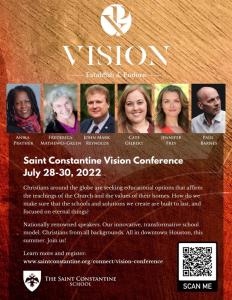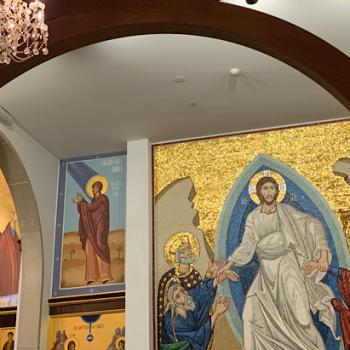 Students return, professors are prepared, staff is ready: education continues. I love this time of year: fresh Moleskine for my notes, reading Homer and Thucydides for class, getting ready for HBU’s first home football game. . . ever.
Students return, professors are prepared, staff is ready: education continues. I love this time of year: fresh Moleskine for my notes, reading Homer and Thucydides for class, getting ready for HBU’s first home football game. . . ever.
But what is it that we returned to do? Higher education is in turmoil nationally about this very question,but last week I heard a great answer. Watch my University President Robert Sloan give higher education a vision, at least if you made the wrong choice and are not here to have seen it yourself, or (second best) read my thoughts on these aspirational words. Perhaps your school could watch the video and discuss the ideas in it.
My Personal Preface
If people perish without a vision, HBU will never perish with this President. The first characteristic of a higher education is vision. If a school has to hire a vision, or find it, then there will be no authentic vision. Higher education requires a goal, a dream, and a worthy reason for everything it does. This, more than anything else, is the job of the Trustees and the President, but all the rest of us need to understand that goal.
We may make mistakes, but we must never mistake where we are going. This should matter to students, and to the family of students, because without a clearly stated vision, schools and universities end up corrupted.
Why?
If I have my goal for a “higher education at HBU” and every professor has his or her own private vision, then we end up offering a cafeteria of choices without any context in which to accept or reject that vision.
Do not be deceived by public relations: every school has a vision statement. Try this experiment to see if the vision statement is more than a slogan forgotten in practice: ask any faculty member at the school if actions taken every year in every department have the vision in mind. Is the vision specific enough to be used? Usually the answer is that leadership produces a “little red book” and then ignores it when the “practical business” starts.
A vision not incarnated in practical decisions perishes.
Of course, there is the opposite danger, though no modern state school and few religious schools run into it. There are a few schools with controlling leaders or overly robust specificity to their “vision.” Higher education should not be overly specified! A school whose statement of faith or vision statement runs to what feels like book length will find it hard to attract enough people who can really buy into the vision.
Academic freedom matters. If too many issues are “off the table,” there is too little about which to argue, develop or grow. But academic freedom is not the only good. Community around a common good matters as much! Individual schools have individual visions to realize the good life. Each school will see things differently (in the broad sense), but unite around a common ideal of the good life.
The diversity of schools in America provides a place to see which vision is best when worked out in the lives of the graduates. We should always be in a place where we can share that general goal.
Early Assumptions Regarding Higher Education in this Address
Coming to college marks a transition to adulthood. In America, college is when we fully pass from childhood to adulthood. If anybody gets this it is President Sloan: parent of seven with seventeen grandchildren under eight!
The implication for me as a parent is that I must let go of my old role. I am always my college kids’ father, but I am no longer making the decisions. They are. Of course, if they ask for money, or live in my house, there are strings attached, but those are negotiated between adults. My adult children honor me the best they can, but they do not obey me.
As the parent of three college students, I heard the talk by Dr. Sloan and got a healthy reminder not to cling!
The President loves education. School is a joyful time for him and it should be for all of us in education. Higher education is not a scary, hostile, foreign place for a Christian. We founded the system in earlier centuries and have always been a part of it! Avoid a place or becoming a place that is grim all the time. “It is a wonderful time of year.”
We are here to help students find a job and a career. That is not all a higher education does, but it had better do at least this task! Do not cut yourself off from the world when you live at school. I thought about this as I looked at our student body: we are educating a student body that is what America will be in 2050, rather than looking like America in 1950.
Part of that education is learning to have grownup fun. Degenerates make “adult” an adjective for entertainment that harms, but students are also not called to remain children. Education introduces through faculty lives and by organized events how to spend free time fruitfully and with maturity. Going to the Alma Mater’s game after a tailgate with friends is a lifetime joy.
We are not afraid to hold a party, but we are also unafraid of saying some entertainment is not for us.
Christian Education Has a Biblical Mandate
Any religious school can quote a passage, slap a Bible verse on their mission, but a Christian school should engage the text and obey it. This job is key for anyone who works at a Christian educational institution and requires leaders who can read, exegete, and implement.
Scripture is a big textual place. Where should we begin?
President Sloan points to a section of Colossians chapter 1, which may have been an early Christian hymn, as a statement of bedrock truths of the Faith.
9 For this cause we also, since the day we heard it, do not cease to pray for you, and to desire that ye might be filled with the knowledge of his will in all wisdom and spiritual understanding;10 That ye might walk worthy of the Lord unto all pleasing, being fruitful in every good work, and increasing in the knowledge of God;11 Strengthened with all might, according to his glorious power, unto all patience and longsuffering with joyfulness;12 Giving thanks unto the Father, which hath made us meet to be partakers of the inheritance of the saints in light:13 Who hath delivered us from the power of darkness, and hath translated us into the kingdom of his dear Son:14 In whom we have redemption through his blood, even the forgiveness of sins:15 Who is the image of the invisible God, the firstborn of every creature:16 For by him were all things created, that are in heaven, and that are in earth, visible and invisible, whether they be thrones, or dominions, or principalities, or powers: all things were created by him, and for him:17 And he is before all things, and by him all things consist.18 And he is the head of the body, the church: who is the beginning, the firstborn from the dead; that in all things he might have the preeminence.19 For it pleased the Father that in him should all fulness dwell;20 And, having made peace through the blood of his cross, by him to reconcile all things unto himself; by him, I say, whether they be things in earth, or things in heaven.21 And you, that were sometime alienated and enemies in your mind by wicked works, yet now hath he reconciled22 In the body of his flesh through death, to present you holy and unblameable and unreproveable in his sight:23 If ye continue in the faith grounded and settled, and be not moved away from the hope of the gospel, which ye have heard, and which was preached to every creature which is under heaven; whereof I Paul am made a minister. . .
The implications of this section of Paul will require three more sections to unpack!
















